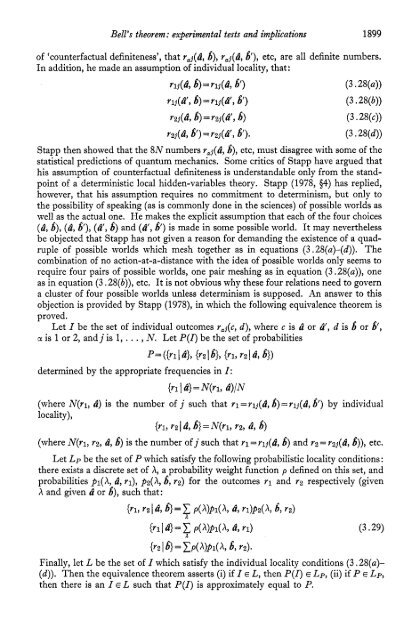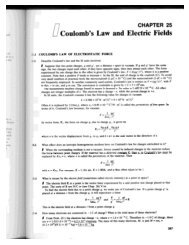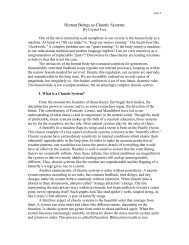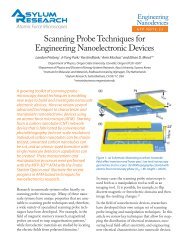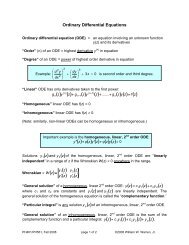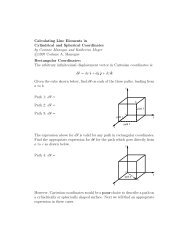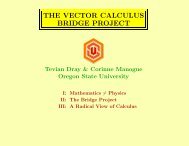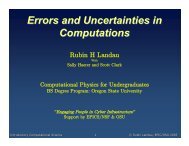Bell's theorem : experimental tests and implications - Physics at ...
Bell's theorem : experimental tests and implications - Physics at ...
Bell's theorem : experimental tests and implications - Physics at ...
You also want an ePaper? Increase the reach of your titles
YUMPU automatically turns print PDFs into web optimized ePapers that Google loves.
Bell’s <strong>theorem</strong> : <strong>experimental</strong> <strong>tests</strong> <strong>and</strong> <strong>implic<strong>at</strong>ions</strong> 1899of ‘counterfactual definiteness’, th<strong>at</strong> raj(&, 6), raj(ci, I?), etc, are all definite numbers.In addition, he made an assumption of individual locality, th<strong>at</strong>:rlj(d, 6)=r1,(d, 61)?lj(cil, 6)=rlj(d’, a’)(3.28(a))(3 * 2W))rag(d, 6) = r23(d’, 6) (3* 2W)rzj(ci, 6’) = r2j(d1, Q.(3*28(d))Stapp then showed th<strong>at</strong> the 8N numbers rap(&, a), etc, must disagree with some of thest<strong>at</strong>istical predictions of quantum mechanics. Some critics of Stapp have argued th<strong>at</strong>his assumption of counterfactual definiteness is underst<strong>and</strong>able only from the st<strong>and</strong>pointof a deterministic local hidden-variables theory. Stapp (1978, $4) has replied,however, th<strong>at</strong> his assumption requires no commitment to determinism, but only tothe possibility of speaking (as is commonly done in the sciences) of possible worlds aswell as the actual one. He makes the explicit assumption th<strong>at</strong> each of the four choices(d, 6), (d, 6’), (d’, 6) <strong>and</strong> (d’, 6‘) is made in some possible world. It may neverthelessbe objected th<strong>at</strong> Stapp has not given a reason for dem<strong>and</strong>ing the existence of a quadrupleof possible worlds which mesh together as in equ<strong>at</strong>ions (3.28(a)-(d)). Thecombin<strong>at</strong>ion of no action-<strong>at</strong>-a-distance with the idea of possible worlds only seems torequire four pairs of possible worlds, one pair meshing as in equ<strong>at</strong>ion (3.28(a)), oneas in equ<strong>at</strong>ion (3.28(b)), etc. It is not obvious why these four rel<strong>at</strong>ions need to governa cluster of four possible worlds unless determinism is supposed. An answer to thisobjection is provided by Stapp (1978), in which the following equivalence <strong>theorem</strong> isproved.Let I be the set of individual outcomes raj(c, d), where c is d or d’, d is 6 or 6’,01 is 1 or 2, <strong>and</strong>j is 1, . . . , N. Let P(I) be the set of probabilitiesp= ({rl I d}, {r2 I S}, {Tl, y2 I ci, 6))determined by the appropri<strong>at</strong>e frequencies in I:{Tl I d}= N(r1, d)/N(where N(r1, ci) is the number of j such th<strong>at</strong> rl =rlj(d, 6)=qj(d, 6’) by individuallocality),{ri, r2 I d, 6) = ~ (ri, r2, d, 6)(where N(r1, r2, d, 6) is the number of j such th<strong>at</strong> r1= rlj(d, 6) <strong>and</strong> r2 = 1.44 s)), etc.Let LP be the set of P which s<strong>at</strong>isfy the following probabilistic locality conditions:there exists a discrete set of A, a probability weight function p defined on this set, <strong>and</strong>probabilities p1( A, d, TI), p4 A, 6, r2) for the outcomes rl <strong>and</strong> r2 respectively (givenA <strong>and</strong> given d or 6), such th<strong>at</strong>:{n, r214 6>=C P(AlPl(A, 4 r1lp2(A, 6, y2)1{rl I ci> = C P(4Pl( A, ci, r1) (3.29)A{r21~)=CP(A)Pl(A, 6, r2).Finally, let L be the set of I which s<strong>at</strong>isfy the individual locality conditions (3 .28(a)-(d)). Then the equivalence <strong>theorem</strong> asserts (i) if I E L, then P(I) E Lp, (ii) if P E LP,then there is an I E L such th<strong>at</strong> P(I) is approxim<strong>at</strong>ely equal to P.


